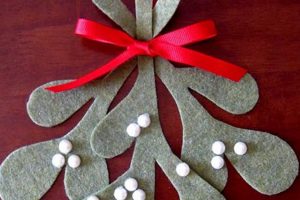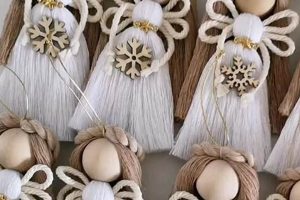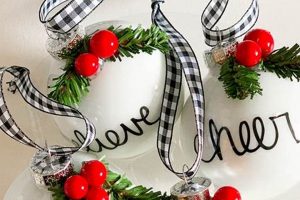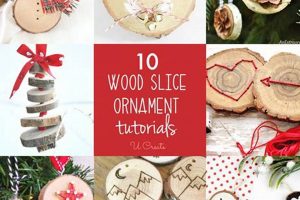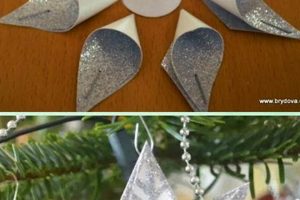The creation of personalized festive decorations using wooden materials presents a popular crafting activity during the holiday season. These handmade items, often incorporating techniques such as painting, carving, or wood burning, serve as unique additions to Christmas trees and holiday displays. Examples include painted wooden stars, carved reindeer figures, and ornaments decorated with pyrography.
The significance of crafting personalized Christmas decorations lies in the opportunity for creative expression, the development of handcrafting skills, and the creation of heirloom-quality items. This activity offers a cost-effective and environmentally conscious alternative to mass-produced ornaments. Historically, the tradition of crafting decorations from natural materials aligns with sustainable practices and reflects a desire to personalize holiday celebrations.
The following sections will explore various methods and techniques for creating these festive wooden embellishments, including selecting appropriate wood types, applying decorative finishes, and incorporating diverse design elements to produce visually appealing and durable holiday decorations.
Essential Guidance for Crafting Wooden Christmas Ornaments
Effective creation of festive wooden ornaments necessitates attention to detail and adherence to best practices. The following tips provide guidance on material selection, design considerations, and finishing techniques to ensure optimal results.
Tip 1: Wood Selection: Employ hardwoods such as birch or maple for increased durability and finer grain. Softwoods like pine are acceptable but may require additional sanding to achieve a smooth surface. Ensure the wood is kiln-dried to prevent warping or cracking.
Tip 2: Design Planning: Prior to commencing work, develop a detailed design that specifies dimensions, shapes, and decorative elements. A scaled drawing or digital rendering can aid in visualization and prevent errors during the crafting process.
Tip 3: Precision Cutting: Utilize appropriate tools, such as a scroll saw or laser cutter, to achieve accurate and clean cuts. Exercise caution and wear appropriate safety equipment, including eye protection, during all cutting operations.
Tip 4: Surface Preparation: Thoroughly sand all surfaces with progressively finer grits of sandpaper to create a smooth base for painting or staining. Remove dust particles with a tack cloth prior to applying any finishes.
Tip 5: Paint Application: Opt for acrylic paints formulated for wood. Apply thin, even coats and allow adequate drying time between each coat. Consider using stencils or fine-tipped brushes for intricate designs.
Tip 6: Sealing and Protection: Apply a clear sealant or varnish to protect the painted or stained surfaces from moisture and abrasion. Select a finish appropriate for the intended use environment. Multiple thin coats are preferred over a single thick coat.
Tip 7: Secure Attachment: Employ durable adhesives or small screws to securely attach hanging loops or decorative elements. Test the strength of the attachment before hanging the ornament on a tree.
The successful creation of lasting wooden ornaments is dependent on meticulous planning, precise execution, and the application of protective finishes. Adhering to these guidelines enhances the aesthetic appeal and longevity of the finished product.
Subsequent sections will delve into specific design styles and decorative techniques to further refine the creation of individualized wooden Christmas ornaments.
1. Material Selection
The selection of appropriate wood types is a fundamental aspect of creating durable and aesthetically pleasing festive wooden ornaments. The chosen material directly impacts the ornament’s longevity, susceptibility to damage, and suitability for various decorative techniques.
- Wood Density and Durability
Denser hardwoods, such as maple or oak, offer superior resistance to dents, scratches, and breakage compared to softer woods like pine or balsa. This is particularly relevant for ornaments intended to be heirlooms or frequently handled. For example, a maple ornament is less likely to be damaged during storage than one crafted from balsa.
- Grain Pattern and Aesthetic Appeal
The grain pattern of the wood influences the visual texture and overall aesthetic of the ornament. Fine-grained woods, like birch, provide a smoother surface for painting or staining, while woods with prominent grain patterns, such as ash, can add visual interest when left exposed or selectively stained. A craftsman might choose walnut for its rich color and distinctive grain.
- Workability and Tooling Requirements
Different wood species exhibit varying degrees of workability, affecting the ease of cutting, shaping, and carving. Softwoods are generally easier to cut but may require more careful sanding to achieve a smooth finish. Hardwoods demand sharper tools and greater precision but often yield cleaner edges and finer details. Pine is often chosen by beginners due to its relative softness.
- Finish Compatibility and Absorption Rates
The chosen wood type influences the absorption rate and compatibility with various finishes, such as paints, stains, and sealants. Porous woods may require more coats of paint or stain to achieve the desired color saturation. Certain wood species may react adversely to specific finishes, leading to discoloration or uneven coverage. For instance, cherry wood’s color deepens significantly with certain oil-based finishes.
Careful consideration of these material properties is paramount to ensure the creation of wooden festive decorations that are not only visually appealing but also capable of withstanding the test of time, thereby enhancing the overall value and enjoyment derived from these handcrafted items.
2. Design Complexity
The design complexity inherent in crafting wooden festive ornaments significantly influences both the required skill level and the time investment involved. A direct correlation exists between the intricacy of the design and the difficulty of execution. Simple geometric shapes, for instance, demand minimal woodworking experience and can be efficiently produced with basic tools. Conversely, designs incorporating detailed carvings, complex joinery, or multi-layered constructions necessitate advanced skills, specialized equipment, and substantially more time. A rudimentary wooden star ornament represents a low-complexity design, while a miniature replica of a Victorian-era house crafted from wood presents a high-complexity endeavor. Therefore, design complexity serves as a primary determinant of the project’s feasibility and the resources required for its completion.
The choice of design complexity also impacts the aesthetic outcome and the overall perceived value of the finished ornament. Intricate designs often convey a sense of craftsmanship and artistry, potentially elevating the ornament from a simple decoration to a cherished keepsake. Furthermore, complex designs may incorporate diverse woodworking techniques, such as wood burning, inlay, or relief carving, adding layers of visual interest and textural contrast. For example, an ornament featuring a hand-carved depiction of a winter landscape demonstrates a higher degree of artistic merit than a plain, painted wooden circle. The selection of an appropriate design complexity should therefore align with the intended purpose, aesthetic preferences, and available skill set.
Ultimately, the relationship between design complexity and the construction of wooden festive ornaments hinges on a balance between ambition and practicality. While intricate designs offer the potential for exceptional aesthetic results, they also require significant expertise and time commitment. A prudent approach involves carefully evaluating one’s skill level, available resources, and desired outcome before embarking on a project. Simplifying a complex design or gradually increasing complexity with successive projects can provide a more manageable and rewarding crafting experience. This balanced approach ensures the creation of meaningful and well-executed wooden festive ornaments that enhance the holiday season.
3. Cutting Precision
Cutting precision is a critical determinant of the final quality and aesthetic appeal of wooden Christmas ornaments. Inaccurate or imprecise cuts compromise the intended design, weaken structural integrity, and detract from the overall presentation. This holds true across various ornament styles, from simple geometric shapes to complex, multi-layered creations. For instance, if a wooden star ornament’s points are not cut at precise angles, the resulting shape will appear distorted and unprofessional. Similarly, if pieces intended for interlocking assembly are imprecisely cut, they may not fit together correctly, rendering the ornament structurally unsound. Therefore, the correlation between cutting precision and the desired outcome for festive wooden ornaments is direct and substantial.
Achieving adequate cutting precision necessitates the use of appropriate tools and techniques, commensurate with the design’s complexity and the wood’s properties. A scroll saw, for example, offers greater maneuverability and control for intricate cuts than a standard jigsaw. Laser cutters provide unparalleled precision for complex shapes but require specialized equipment and expertise. Hand-sawing, while feasible for simpler designs, demands a high degree of skill and patience to maintain accuracy. Furthermore, the choice of blade or cutting bit must be appropriate for the wood species to minimize splintering or chipping. Proper clamping and securing of the workpiece are also essential to prevent movement during the cutting process. Examples of precise cuts are evident in well-defined edges, smooth curves, and accurate dimensions in finished ornaments.
In summary, cutting precision is an indispensable element in the creation of high-quality wooden Christmas ornaments. The application of appropriate tools, techniques, and meticulous execution directly translates into aesthetically pleasing, structurally sound, and professional-looking decorations. Challenges associated with achieving precision cuts can be mitigated through practice, proper tool maintenance, and a thorough understanding of woodworking principles, ultimately contributing to the successful realization of festive, handmade wooden ornaments that enhance the holiday season.
4. Finishing Techniques
Finishing techniques constitute a critical phase in the creation of durable and visually appealing wooden Christmas ornaments. These techniques, applied after the shaping and construction stages, serve to protect the wood, enhance its aesthetic qualities, and prolong the ornament’s lifespan. The connection between appropriate finishing and the overall success of crafting a wooden ornament is direct; inadequate or inappropriate finishing can lead to premature deterioration, discoloration, or diminished visual appeal. For example, an unfinished wooden ornament exposed to moisture may warp or crack, while one finished with a non-UV-resistant coating may fade when exposed to sunlight. Therefore, proper finishing is not merely a decorative step, but a functional imperative.
The range of applicable finishing techniques encompasses several options, each offering distinct advantages and disadvantages. Painting, staining, sealing, varnishing, and the application of specialized coatings like polyurethane are common choices. Painting provides the opportunity for extensive color customization and the incorporation of detailed designs. Staining enhances the natural grain of the wood while adding color depth. Sealants protect the wood from moisture and environmental contaminants. Varnishes provide a durable, glossy finish, while polyurethane offers enhanced resistance to scratches and abrasion. The selection of an appropriate finishing technique depends on factors such as the type of wood used, the desired aesthetic outcome, and the intended use environment. A pine ornament intended for outdoor display, for example, would benefit from a weather-resistant sealant or varnish.
In conclusion, finishing techniques are an indispensable component in the fabrication of quality wooden Christmas ornaments. Their proper application ensures both the aesthetic appeal and the structural integrity of the finished product, contributing to its longevity and enjoyment for years to come. Challenges may arise in selecting the most appropriate technique for a given project, but informed decision-making, based on a clear understanding of wood properties and finish characteristics, will ensure the successful creation of enduring and visually pleasing festive decorations.
5. Hanging Security
The reliable suspension of handcrafted wooden Christmas ornaments necessitates careful consideration of attachment methods and load-bearing capabilities. The security with which these ornaments are affixed to a Christmas tree or other display directly affects their longevity and preserves their aesthetic presentation, mitigating the risk of damage or breakage.
- Attachment Point Strength
The structural integrity of the point where the hanging mechanism connects to the wooden ornament is paramount. Weak or improperly attached hardware, such as eye hooks or screw eyes, can fail under the ornament’s weight, leading to a fall. For instance, using an insufficient adhesive to secure a hanging loop to a dense hardwood ornament will likely result in detachment. The selection of appropriately sized and robust attachment hardware is crucial.
- Hanging Mechanism Durability
The hanging mechanism itself, encompassing elements such as wire, string, ribbon, or cord, must possess adequate tensile strength to support the ornament’s weight over extended periods. Degradation from environmental factors, such as humidity or temperature fluctuations, can compromise the integrity of these materials. Selecting materials resistant to stretching, fraying, or corrosion is essential. A thin cotton thread, for example, may be unsuitable for supporting a heavier wooden ornament.
- Weight Distribution and Balance
Uneven weight distribution within the ornament can exert excessive stress on the hanging mechanism or attachment point. Ensuring that the ornament is properly balanced, with the center of gravity aligned with the suspension point, minimizes the risk of tilting or falling. A top-heavy ornament, for instance, is more susceptible to dislodging from its hanging point due to instability.
- Environmental Factors and Placement
External factors, such as wind exposure if the ornament is displayed outdoors or accidental contact from passersby, can impact hanging security. Placement of ornaments in protected locations, away from high-traffic areas or strong drafts, can mitigate these risks. Furthermore, using secure ornament hangers designed to grip tree branches firmly can prevent accidental displacement.
In summary, ensuring the secure hanging of handcrafted wooden Christmas ornaments requires a holistic approach encompassing robust attachment hardware, durable suspension materials, balanced weight distribution, and mindful placement. Attention to these factors enhances the longevity and aesthetic preservation of these festive creations, safeguarding them from potential damage or loss.
Frequently Asked Questions
The following addresses common inquiries regarding the creation, maintenance, and longevity of wooden Christmas ornaments. The aim is to provide clear, concise answers based on established woodworking practices.
Question 1: What wood types are best suited for crafting durable Christmas ornaments?
Hardwoods, such as maple, oak, and birch, generally offer greater resistance to damage and are suitable for ornaments intended to last for many years. Softwoods like pine can be used, but may require additional care to prevent dents or scratches.
Question 2: How can warping or cracking of wooden ornaments be prevented?
Employing kiln-dried wood is crucial in minimizing the risk of warping or cracking. Additionally, applying a sealant or varnish helps regulate moisture absorption and prevent dimensional changes caused by humidity fluctuations.
Question 3: What paints are recommended for decorating wooden Christmas ornaments?
Acrylic paints formulated for use on wood are generally recommended due to their durability, colorfastness, and ease of application. Oil-based paints can also be used, but require longer drying times and proper ventilation.
Question 4: How should the hanging mechanism be securely attached to a wooden ornament?
Employing durable adhesives specifically designed for wood bonding is essential. Additionally, small screws or eye hooks can be used to reinforce the attachment point, particularly for heavier ornaments. The weight-bearing capacity of the chosen attachment method must be considered.
Question 5: How can the painted or stained finish of a wooden ornament be protected from damage?
Applying a clear sealant or varnish over the painted or stained surface provides a protective layer against scratches, moisture, and UV damage. Multiple thin coats are generally preferred over a single thick coat to ensure even coverage and prevent drips or runs.
Question 6: How should wooden Christmas ornaments be stored to ensure their longevity?
Ornaments should be stored in a cool, dry place away from direct sunlight. Wrapping ornaments individually in acid-free tissue paper can prevent scratches and protect delicate features. Avoid storing ornaments in excessively humid or temperature-fluctuating environments.
In summary, the creation and preservation of wooden Christmas ornaments require attention to material selection, construction techniques, finishing procedures, and storage practices. Adherence to these guidelines will enhance the longevity and aesthetic appeal of these handcrafted items.
The following section will explore advanced techniques and decorative styles for enhancing wooden Christmas ornaments.
Conclusion
This exploration of diy christmas ornaments wood has addressed fundamental aspects of their creation, ranging from material selection and design complexity to cutting precision, finishing techniques, and hanging security. The information presented underscores the importance of informed decision-making in each stage of the crafting process to ensure both aesthetic appeal and long-term durability. Specific attention to detail, from selecting appropriate wood species to applying protective finishes, significantly impacts the longevity and visual quality of these handcrafted decorations.
The enduring appeal of crafting personalized festive decorations lies in the tangible connection to tradition and the opportunity for individual creative expression. While mass-produced ornaments offer convenience, the act of creating diy christmas ornaments wood fosters a sense of accomplishment and contributes to the preservation of handcrafting skills. Continued exploration and refinement of these techniques will ensure the ongoing relevance and appreciation of these timeless holiday embellishments.



